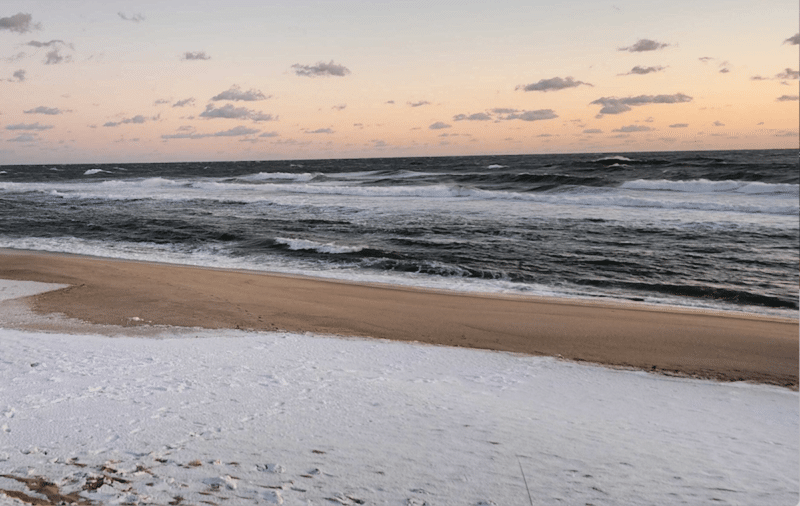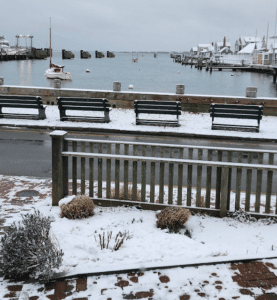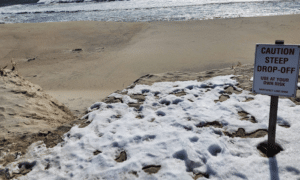by Robert P. Barsanti
Snow falls someplace else.
When it appears on Nantucket, the flakes are picked up and whipped over from the Cape until they get caught in the grass and sand of the island.
For a geological second, the snow clings to the sand and the stalks before the sun appears, the wind shifts, and the snow retreats to the shadows, then disappears.
We have had storms that drop inches and even feet of snow. In one of my early years on-island, we had a snow day every Monday for a month. A snowstorm came rolling up the coast, went out to sea missing Boston and blessing us with a new world of white.
A heavy snow on the island transforms us. We spend all eight months of November staring at the same brown and gray. Our familiar world contracts into groceries, work, and a warped front door. Then the snow comes and comes and comes, generally on the back of a heavy north-westerly wind. It drifts into surrealist peaks and carves out bare ground in between drifts. It tucks into the hollows of the dunes and gets packed down into the cracks of the cobblestones. With enough snow, the sleds, cookie sheets, and the cardboard come out. For several winters, the town would close Orange and Main streets so the kids would have a gentle slope to slide down (over the cobblestones) and the photographers would have young models for the calendars. Just beyond the historical town, the young people who had grown too large for snow suits and hot chocolate came whistling down the hill at Dead Horse Valley, inevitably over some improvised jump or another.
The rest of us, freed from most of our careers for the day, re-embraced our family and toured our snow world. Milestone and Polpis Road had been reimagined in snowy peaks and curves, the ocean had peaked up over its edges, and the wind left streaks of ice. Winter brought a Canadian blue sky, interpretive snow banks, and a day off the ladder or the bus.
But just a day. Soon, it was fifty degrees and raining. The brown and the gray reasserted control, and the island shook off its costume and returned to its old world in its spectral colors. The ladder took us back.
But in the days and years since then, the water has warmed, the polar vortex has shifted, and the rain comes. The builders work continues; nobody gets a day off the ladder. Even when the storms move out to sea and come glancing off of the island, the air and the ocean may be too warm to cancel school and summon the snow plows. Very few Nantucket children get sleds for Christmas.
Today, when the snow falls, I hold that moment. One recent snowfall came at the heels of a long, windy rainstorm, when the temperature dropped and the grapple shotgunned the plastic at the brewery. Inside, several Connecticut families had been stuck and shocked like sea turtles in the winter ocean. They had travelled the island, considered the wave, estimated the tide, and, finally, yielded to the time. Here, the band played “Wagon Wheel” for ten minutes and the wind flapped the plastic every time the door opened. But the afternoon gray ticks of astronomical precision. The minds of summer looked out at the wind and the white, pulled the Snow Goose coat tighter, and ordered another IPA. This was not the island they thought they were buying.
It’s not the island I thought it would be either. My faithful companion and I had toured the ocean’s damage earlier that day. On all of the south shore beaches, the tide had eaten chunks of sand and bluff, then stuffed it into an overfilled ocean. The waves had chewed at our modifications; the parking areas at Cisco and Madaket, the ladder and the dunes at Fisherman’s. Nature continued to tick. The long tailed ducks remained out to sea, punctuating the horizon. A seal swam west under the marching waves. Without our man-made measuring sticks, they seem timeless. For me, I see what isn’t there anymore. We measure the world by what we have done, and what we have done is being brought into the deep and wet.
I know how the beaches work out. I know that the fifteen foot drop from the bluff to the sand at Fisherman’s will fill in by May. By July, the $20,000 dollar-a-week visitors, the renters, and their guests will drive out to Cisco, park in a new lot, and won’t see what has gone. Surfboard, fishing pole, and towel; the beach will remain post card perfect as it slips more of the land into itself. So it goes.
We live on a contradiction. The community works to create an island outside of time, with a downtown preserved in centuries of amber. Yet the ocean, the wind, and the weather shape a new island year to year, month to month, day to day. Easy and Broad Street flood with an easy familiarity, measured on the seat post of an abandoned bike. The sewer beds, serviced by new pipes, has a new ocean front view. Every storm presents us with a new island, not necessarily one that we moved to bought or will be living on for long.
This winter, I have noticed the walkers. At any hour of the day, or night, you can find a man in work boots and jeans, carrying a plastic bucket of tools, and hunched under a gray hoodie. Without a car, without a coat, and probably without a bed, he, at least, had work. On this night, as the sky crusted the roads in pellets of ice and snow, he walked up Surfside Road in the cold and the dark. I don’t know where he works, or where he sleeps. I only know where he walks.
And while he walks, I wonder how long he can continue to work out here. The pay on the new island is good, but the sleeping bag in the unheated basement floor doesn’t help. For his sake, I hope he can stay out here longer than the snow.
I hope the rest of us can as well.





